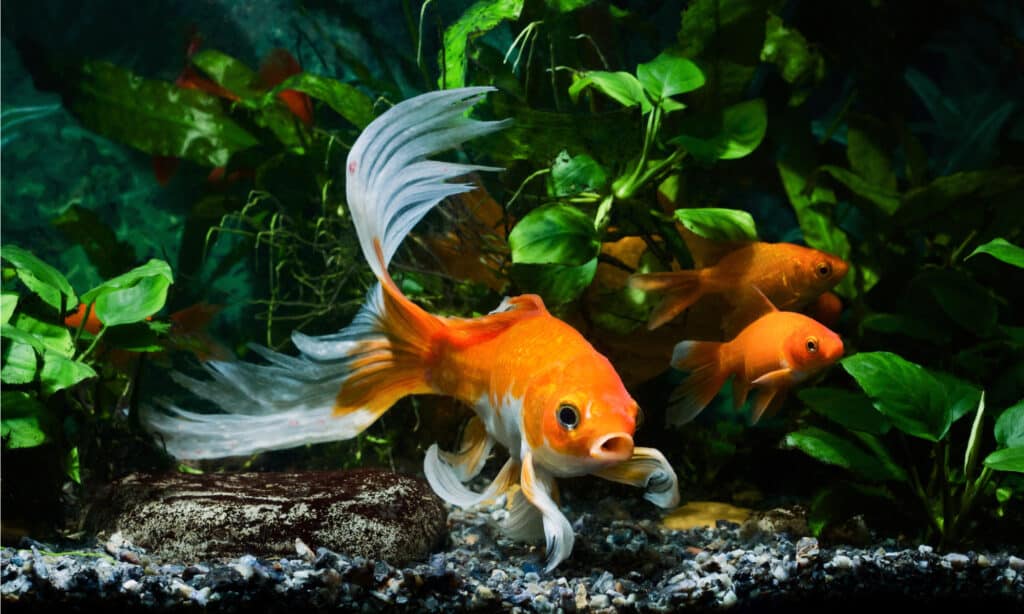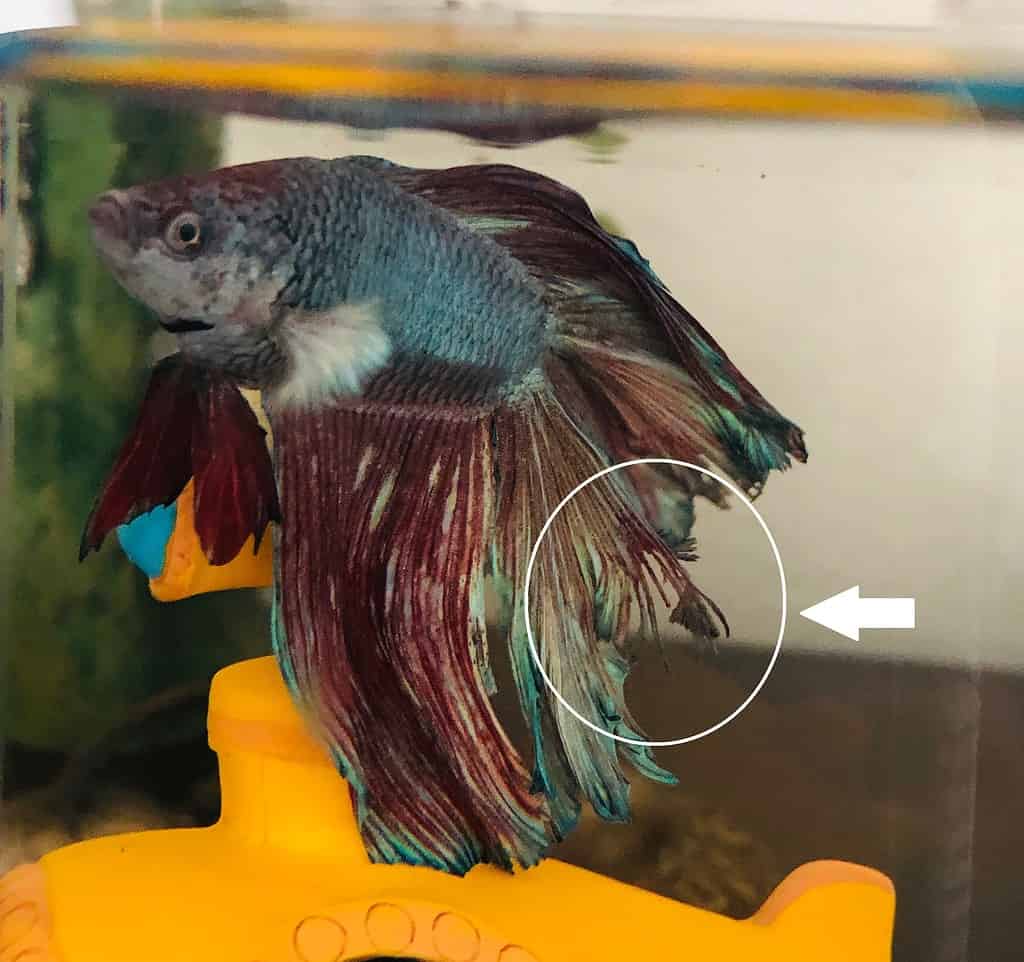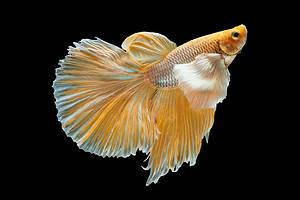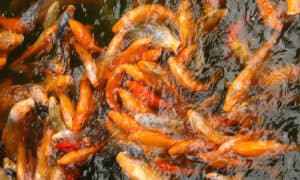Goldfish are one of the best pets to keep. They are small, quiet, clean, and great for beginners. However, although a relatively easy pet to care for, they have needs that must be met. If not, you can end up with a sick fish!
Is your goldfish turning black? This is a common sign that they are sick. Black spots though can indicate multiple causes, like stress. Although there are black goldfish, no fish should randomly develop black spots or markings, but what could this mean? Follow along to learn more about why goldfish turn black and 5 tips to keep your goldfish healthy.
Why do Goldfish Turn Black?

©Aleron Val/Shutterstock.com
There are hundreds of different varieties of goldfish, all ranging in size, color, and shape. Some goldfish are long with thin tails, while others are plump with short tails. Although there are many colors and patterns, nearly all goldfish require the same things and can get sick quickly.
Sometimes, goldfish develop black spots or markings throughout their bodies. The black spots may feel soft and squishy, or hard like a bump. Listed below are a few possible reasons as to why your goldfish is turning black and what to do to treat them.
Ammonia Poisoning
One of the most common reasons a goldfish turns black is ammonia poisoning. This usually happens when a goldfish is transferred to a new tank and it’s not set up right. Although goldfish produce ammonia, they can also die from too much exposure.
Goldfish release ammonia into the water and may harm your fish when levels are high enough. Ammonia though can also build up due to rotting food and plants in a fish tank. When ammonia levels are too high, this can burn your fish’s skin and gills, turning the affected areas black. Eventually, goldfish are left unable to breathe and die.
Ammonia poisoning isn’t always noticeable. Other symptoms though include lethargy, loss of appetite, bleeding, and inflamed gills. You have to act fast to save your goldfish. The best way to determine if your goldfish is suffering from ammonia poisoning is to test the water’s ammonia level.
One way to prevent and help goldfish suffering from ammonia poisoning is to clean the tank and use a nitrogen cycle in the tank. It’s easier though to prevent ammonia poisoning by choosing a tank large enough for the goldfish, avoiding overcrowding and overfeeding them, and regularly cleaning the tanks.
Fin Rot
Another common reason your goldfish is turning black is they are suffering from fin rot. Technically though, fin rot is a symptom, not a disease. Sometimes it’s just a reaction from an injury or something as simple as a dirty tank.
Goldfish fin rot appears as weak and frayed fins, sometimes black, red, or white. Typically though, fin rot is caused by poor water quality. If your tank contains ‘bad bacteria’, this may cause stress to your fish, lowering their immune systems.
Too much of a bad bacteria can eat away at your goldfish’s fins. They may even develop bacterial infections.
It’s not the end of the world though if your fish has fin rot, if you catch it fast enough. You can buy an over-the-counter fin rot treatment or visit a vet for a prescribed antibiotic. Goldfish owners should also deep clean their fish tanks, including any accessories within the tank to get rid of bacteria.

Fin rot is a symptom or reaction that affects betta fish and goldfish.
Black Spot Disease
If you see your goldfish turning black, it may be due to black spot disease. This cause though is relatively rare. It’s more common in outdoor goldfish found in ponds or goldfish housed in tanks with affected snails.
Black spot disease is a parasitic disease that causes dark spots throughout a fish’s body. The black spots are inflamed and raised. Goldfish may even rub themselves against tank accessories, plants, and rocks on their black spots.
If you think your goldfish is turning black because of this disease, you’ll need to remove the snails from the tank and clean the tank to get rid of the parasites. The disease goes away on its own after breaking the cycle.
Overall Stress
Stress is a major reason a fish may turn black. Goldfish are particular animals. Although sold in major pet stores in small tanks and containers with several other fish, overcrowding can cause stress. A stressed-out fish is more likely to get sick as their immune system decreases. If nitrate or ammonia levels are too high, this may stress your goldfish, leading to a change in color, frantic swimming, frequent hiding, and loss of appetite.
5 Tips to Keep Your Goldfish Healthy
Goldfish are easy to maintain but may be tricky for new fish owners. Listed below are a few key tips to keep your goldfish healthy.
Maintain Water Quality

The ideal pH level for a goldfish’s tank is between 7.4 to 7.9.
©chomplearn/Shutterstock.com
Low water quality is a big reason that goldfish don’t grow, die young, and get sick. Goldfish require a pH level between 7.4 and 7.9. If this level drops too low, it invites problems like an increase in ammonia, which leads to ammonia poisoning. Using just tap water in your goldfish’s tank is not enough either. Tap water contains additional chemicals which may be harmful. You’ll need to treat the water before using it in your tank. Goldfish can also be picky about their ideal temperature. Water temperatures over 75°F can be too hot, while 55°F or lower is too cold. Goldfish will stop eating if the temperature drops too low. Some goldfish though in outdoor ponds may survive freezing winters.
Feed Fish on a Strict Schedule
Overfeeding is never a good idea. Too much food for your goldfish can cause it to bloat. Goldfish don’t know when to stop eating and will stuff their mouths, even when full. Even if a goldfish stops eating, the leftover food falls to the bottom of the tank and slowly rots, producing ammonia. To avoid overfeeding your goldfish friend, it’s best to feed your fish on a schedule. Goldfish also don’t need to eat a lot. You can feed your goldfish about 2 to 3 times a day, and only a small amount.
Add Live Plants

Fish owners can add live plants to fish tanks.
©muaiyayo/Shutterstock.com
Live plants aren’t just for decorative purposes. You can also add them to goldfish tanks for entertainment. Goldfish love hiding in live plants and rubbing themselves on the different textures. They may even nibble on the plants, so if you choose to use some in their tank, choose edible and safe ones. Goldfish are also mischievous. They love to tug and dig up plants, so the plants need to be tough and hardy. A mentally stimulated goldfish is a happy goldfish!
Clean Your Aquarium Regularly
The fourth tip to keep your goldfish happy and healthy is to consistently clean their tank. Although this sounds obvious, it’s easy for time to get ahead of you. But, you’ll need to schedule some time to clean the tank. Cleaning the tank includes replacing and cleaning the filter and any accessories and plants. You don’t need to replace all the water in your fish’s tank as this can also get rid of much-needed good bacteria. A sudden water change may even stress your goldfish.
Use a Large Tank
Last but not least is to choose an appropriately sized fish tank. There is a lot of debate as to the right size for a goldfish. The size of the tank depends on a few factors including the type of goldfish and how many will be in the same environment. The general rule though is 20 gallons of water volume per goldfish. For more than one, add about 10 more gallons. For larger goldfish, like fancy goldfish, you may need even more space, as much as 55 gallons.
The photo featured at the top of this post is © hxdbzxy/Shutterstock.com
Thank you for reading! Have some feedback for us? Contact the AZ Animals editorial team.







